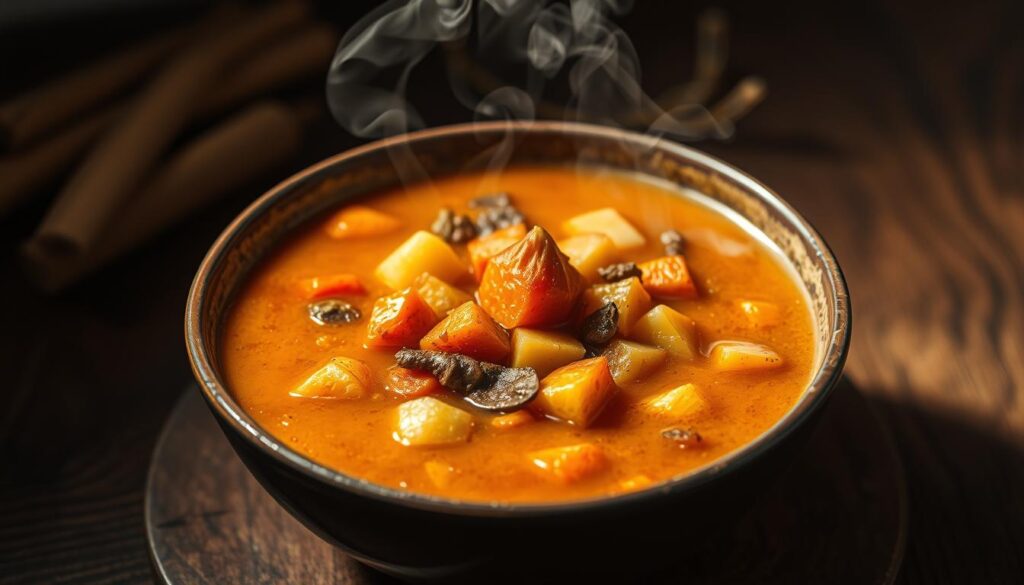As the weather cools, there’s nothing quite like a warm, comforting bowl of vegetable soup to nourish both body and soul. We’re diving into the wonderful world of root vegetables, exploring their earthy flavors and numerous health benefits. Our comprehensive guide will walk you through the process of creating delicious and nutritious soups, from selecting the best ingredients to perfecting your cooking technique.
With a nutritional analysis per serving revealing 264 calories, 13 grams of fat, and 9 grams of dietary fiber, it’s clear that a well-crafted soup can be both satisfying and healthy. For more inspiration on traditional soup recipes, check out our collection of medieval soup recipes.
Key Takeaways
- Learn how to choose the best root vegetables for your soup.
- Understand the nutritional benefits of incorporating root vegetables into your diet.
- Discover techniques for achieving the perfect texture and consistency in your soup.
- Explore traditional and modern approaches to root soup preparation.
- Find out how to balance flavors for a perfectly seasoned bowl.
The Hearty World of Root Soups
As winter sets in, there’s nothing quite like a warm bowl of root soup to comfort and nourish. Root soups stand out for their heartiness and depth of flavor, making them particularly satisfying during colder months. The unique combination of starchy and fibrous root vegetables creates a distinctive texture that can range from chunky to velvety smooth.

What Makes Root Soup Special
The natural sweetness that develops in root vegetables during cooking creates complex flavor profiles. These soups often require minimal seasoning as the vegetables provide rich, earthy flavors. For example, a hearty root vegetable soup can be made with a variety of vegetables, showcasing their versatility.
A Brief History of Root Vegetable Soups
Root soups have been a staple across various cultures throughout history. From medieval European pottages to traditional Asian medicinal broths, these soups have evolved while maintaining their comforting qualities. The Sisters’ Stew is a great example of how root vegetable soups have been adapted across different cultures, highlighting their significance in culinary traditions worldwide.
Understanding Root Vegetables for Your Soup
To create an exceptional root soup, it’s crucial to understand the diverse world of root vegetables and their unique characteristics. Root vegetables form the foundation of any great root soup, each bringing unique flavors, textures, and nutritional profiles to your pot.
Common Root Vegetables and Their Flavors
Various root vegetables contribute distinct flavors and textures to soups. Carrots, parsnips, and turnips are among the most commonly used.
Carrots, Parsnips, and Turnips
Carrots add natural sweetness and vibrant color, while parsnips offer a spicier, more complex sweetness with subtle notes of pepper and licorice. Turnips provide a mild peppery quality and starchy texture, helping to thicken soups naturally.
Potatoes, Sweet Potatoes, and Celery Root
Potatoes can either maintain their shape in chunky soups or break down to create creamier textures, depending on their type. Sweet potatoes add natural sweetness and a velvety texture, whereas celery root contributes a complex, savory note with hints of celery and parsley.
Onions, Garlic, and Leeks
The allium family, including onions, garlic, and leeks, forms the aromatic base of most root soups. Each member offers varying intensities of flavor, from the sharp pungency of garlic to the delicate sweetness of properly prepared leeks.
Selecting and Storing Root Vegetables
Selecting the freshest root vegetables at the market is crucial. Look for firmness, weight, and good skin condition. Proper storage techniques vary by vegetable; some need refrigeration, while others store better in cool, dark places.
Essential Ingredients for the Perfect Root Soup
Elevating a humble root soup to a culinary masterpiece requires attention to detail and the right techniques. We have explored the importance of selecting the right root vegetables, but let’s dive deeper into the essential ingredients and methods that make a root soup truly exceptional.
Beyond the root vegetables themselves, several key ingredients play a crucial role. A proper mirepoix – a classic combination of diced onions, celery, and carrots – provides a foundational flavor that supports the other ingredients. For instance, sautéing onion and celery in butter until tender, about 10 minutes, creates a rich base. Adding garlic cloves and herbs like thyme and bay leaves further enhances the flavor profile.
The choice between water and vegetable stock as a liquid base significantly affects the final flavor. While water allows the natural flavors of the vegetables to shine, vegetable stock can add depth. Seasoning with salt and pepper in layers throughout the cooking process is also crucial. Finally, finishing touches such as a drizzle of olive oil, a dollop of cream, or a sprinkle of fresh herbs can transform a good soup into a great one.
Using an immersion blender to purée the soup until smooth or leaving it chunky depends on the desired texture. For richer flavors, roasting the root vegetables before adding them to the pot can intensify their natural sweetness. By following these guidelines and techniques, you can create a root soup that is not only delicious but also visually appealing and satisfying.


